
The entrance to Yada Tenmangu – and to Alex Kerr’s house
Imagine a small but atmospheric old shrine, with Japanese garden and wild nature beyond. Imagine entering the shrine gate and turning left into a large rambling wooden house you call home. Imagine too just outside your front door is a torii festooned with shimenawa, a functioning shrine and surrounds that are quintessentially Japanese.
For author and entrepreneur Alex Kerr this requires no imagination at all, for it has been his reality since moving into the house in 1977. It originated 400 years ago as lodging for Buddhist nuns and it stands now in the grounds of Yada Tenmangu, a small shrine dedicated to the spirit of Sugawara no Michizane (845-903).
For long the house was used by successive shrinekeepers, but around 1930 it fell into disuse. The shrine however continued to function and today is under the aegis of a nearby priest. (It’s not uncommon for priests to have charge of several, even dozens, of small shrines.)
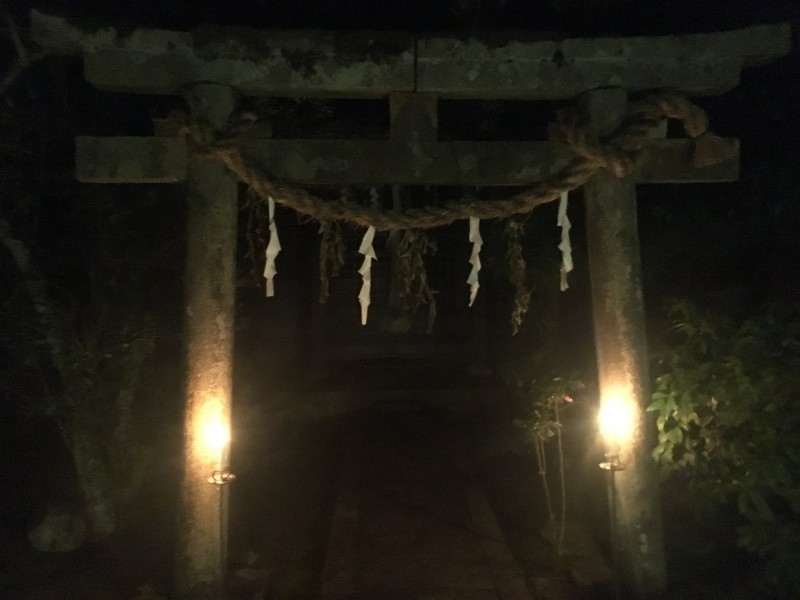
The shrine torii illuminated by candlelight, redolent of a ghostly presence as Lafcadio Hearn would put it
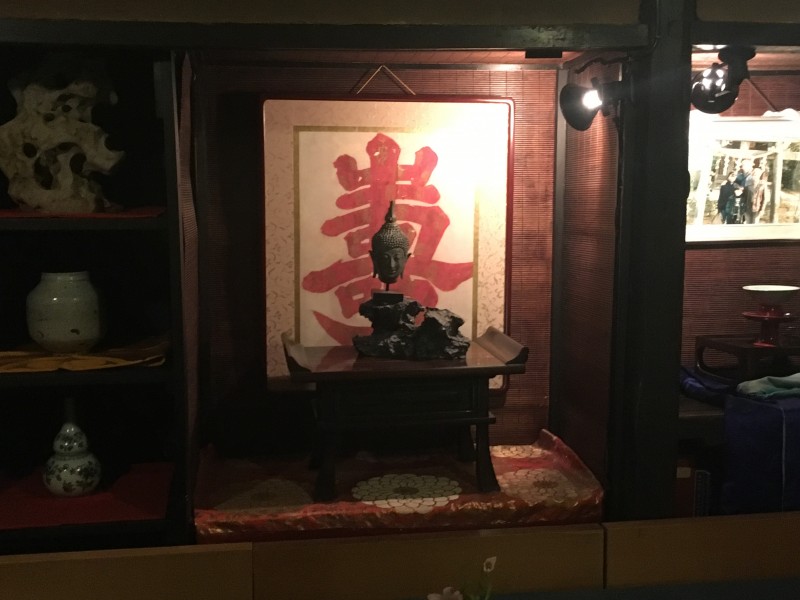
Part of the ad hoc collection of art decorating the rambling rooms
When Alex got permission to occupy the building, there was no electricity or running water, just a well in the kitchen. He had come across it while working in Kameoka with the Oomoto sect, organising traditional culture courses. For the past forty years renovation has been an ongoing process, requiring almost constant attention, as a result of which the spacious rooms now have a comfortable and splendidly bohemian feel. Alongside his other activities Kerr is a dealer in Japanese and Thai artworks, many of which are on display. Traditional fusuma paintings sit cosily alongside modern pieces, including some striking calligraphy by the host. An Aladin’s Cave is how the owner describes the effect in Lost Japan.
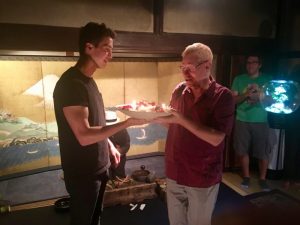
Alex Kerr being presented with his birthday cake.
Such was the setting for Alex’s 65th birthday party, when the rambling house and grounds overflowed with people for what was dubbed ‘a firefly festival’. Along with the eating and dining was some Thai traditional music, a dance performance, the creation of a miniature garden in a glass bowl, and a calligraphic show.
In keeping with the shrine setting was a remarkable performance of kagura (sacred dance). This was given by a former Takarazuka professional, who after retirement from the popular all-female music troupe had taken up the Shinto-style sacred dance, including work at Ise Jingu. A standing screen featuring Mt Fuji acted as backdrop, creating a spiritual focus for the devotional rite (Fuji san is a ‘spirit-body’). The performer entered with fan held before her face so as not to be ‘polluted’ by the gaze of the audience before revealing herself to the kami. In her other hand she carried a sprig of sasaki (sacred plant) and suzu bells, the sound of which acts as auditory purification. With her swirling robes the dancer conveyed all the elegance and beauty of the Japanese tradition at its best.
In the interval between performances guests were invited to walk a couple of minutes down the little road that runs past the house and along a creek, accompanied on the way by a chaotic cacophony of frogs from the adjacent rice fields. On the banks of the stream fireflies paraded like ghostly figures holding tiny fairy lights. It was as if ancestral spirits had emerged from some shadowy otherworld to emit for the brief period of their return a bright spark of delight in the sheer joy of existence.
Lost Japan (1996) is the title of Alex’s breakthrough book. At Yada Tenmangu you can’t help feeling that Lost Japan has truly been found.
********************
For a poetic piece on Alex’s life at Yada Tenmangu, please click here. For an overview of his books, click here. For his Wikipedia page, click here. For his homepage, click here. For a full account of the Tenmangu house, see Chapter 7 of Lost Japan (extract follows below the photos).
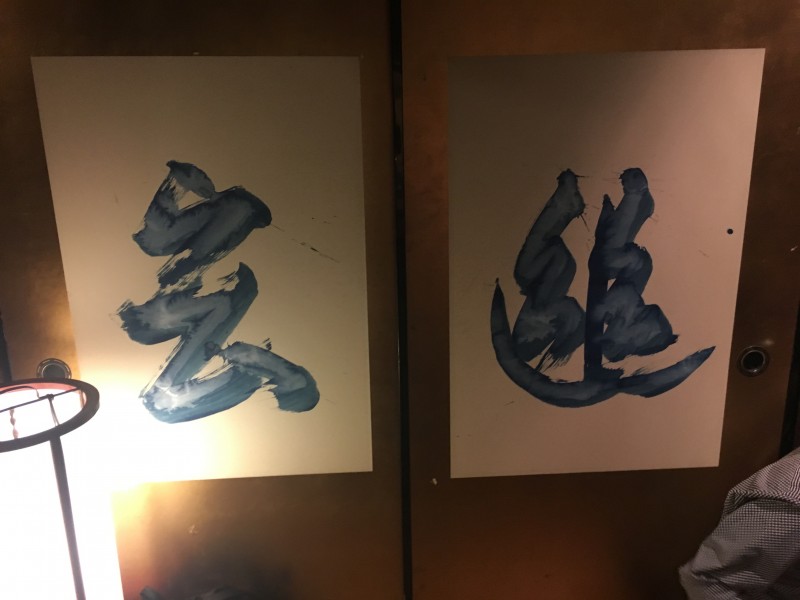
Calligraphy by the multi-talented Alex Kerr

A garden of delights. (photo Heidi Durning)

The kagura begins with shielded face. Attention is diverted thereby to the gorgeous fan and sumptuous clothing
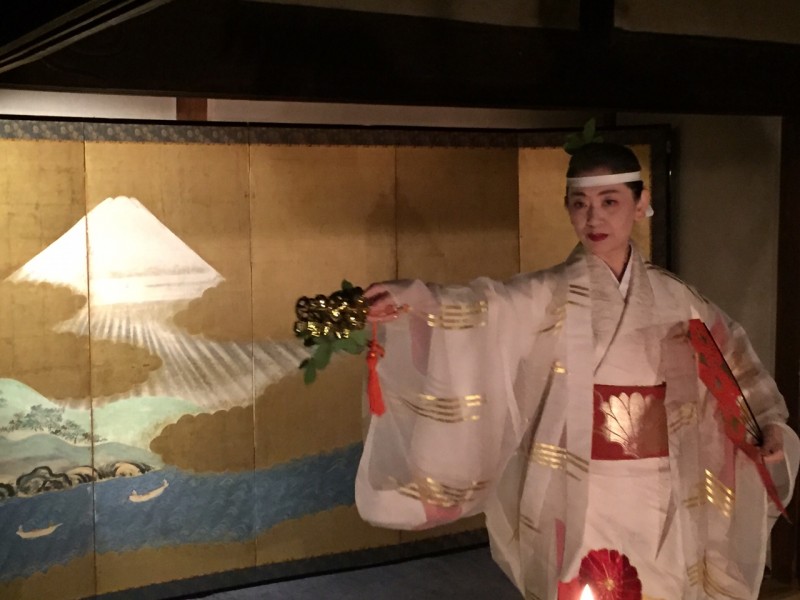
A standing screen with Mt Fuji acted as spiritual focus for the dance

Salute to the kami (photo Heidi Durning)

In one hand an eye-catching fan, in the other a sprig of sasaki and suzu bells. Entertainment fit for the gods.
**********************
From Chapter 7 of Lost Japan by Alex Kerr….
“My home is a traditional Japanese house in the grounds of a small Shinto shrine called Tenmangu, dedicated to the god of calligraphy. Like Chiiori, the house measures four bays by eight bays, but it is tiled rather than thatched. While the house is not large, it has considerable garden space because of its location in the grounds of a shrine. One side of the property fronts a small road, while the other side overlooks a mountain stream; the grounds sandwiched within cover about a thousand tsubo of land. The mountain rising up on the other side of the stream is also shrine property, so the ‘borrowed scenery’ of the garden actually extends over several thousand tsubo. A long white wall with a tiled roof borders the grounds of the shrine on the side towards the road, and in the center of the wall there is a high gate. Entering, you see directly before you a stone torii (the entrance gate to the shrine itself), and a small Tenmangu Shrine with an old plum tree standing beside it. To the right is the ‘shrine forest’, a stand of giant old cryptomeria cedars. To the left of the stone path is my domain. Water lilies float in large pots, and an assortment of vessels scattered here and there hold peonies, ferns, lotuses, Chinese lanterns and heron grass. After crossing six or seven stepping stones, you reach the entrance to my house. When you enter the living room, the back garden comes into view – although ‘jungle’ might be a more appropriate description. Just a few square meters have been cleared near the house, a stretch of grass and moss with some stepping stones in it. The edges of this plot are planted with azaleas and hagi (bush clover), which have been long unattended and are beginning to spread unruly twigs outwards and upwards, hiding a mossy stone lantern and some ceramic statues of badgers. Towards the back are a variety of trees: an ancient cherry tree (propped up with wooden supports), a maple, camellias and a gingko tree. Behind these trees, the garden drops away to a waterfall in the stream, and a heavily wooded mountain soars up from the far bank. When I arrive home on Friday night, I throw open the glass doors of the verandah, and the sound of the waterfall swells up into the house. In that instant, all thoughts of the week in Tokyo blow clean away, and I feel like I have returned to my true self. Finding this house was a piece of great good luck.”

A beautiful post about what must be a lovely spot. Thank you so much.